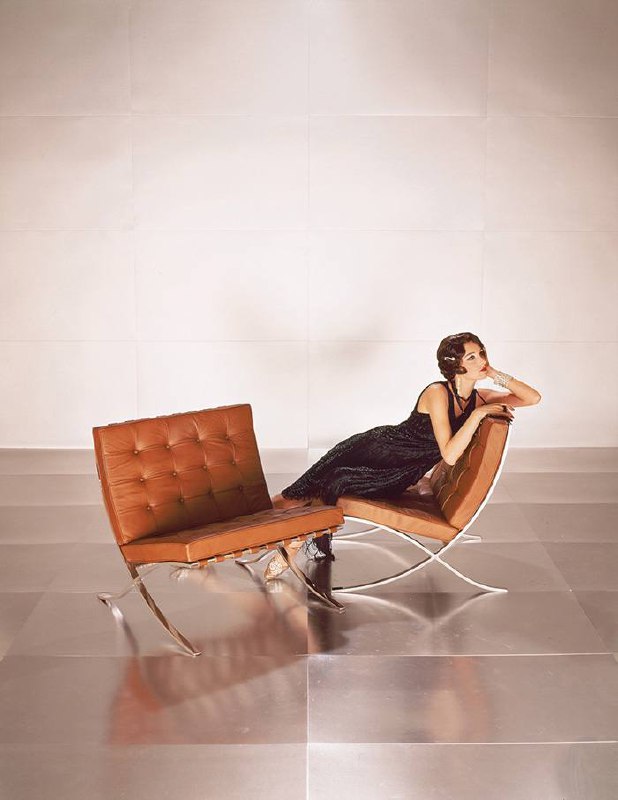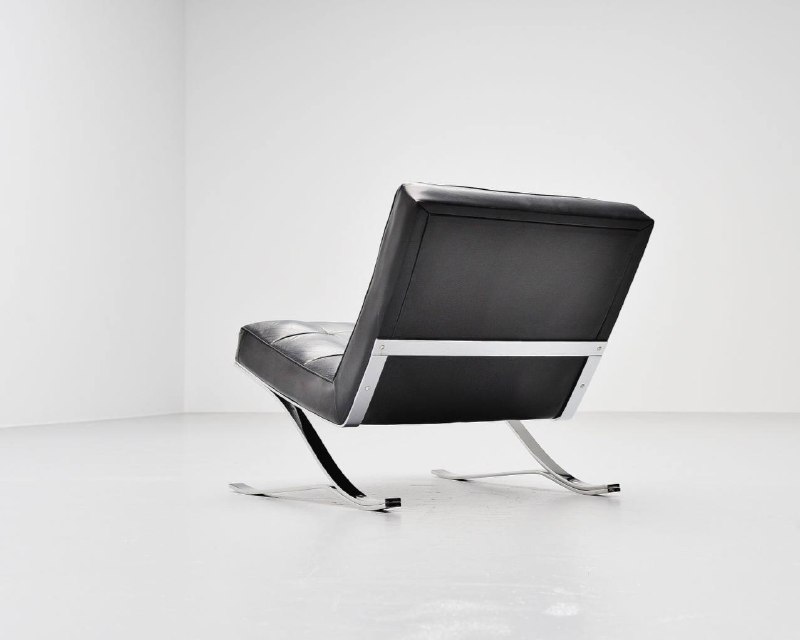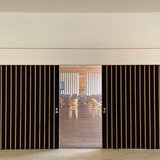Переложите две спички так, чтобы из иконы западногерманского дизайна получилась икона восточногерманского дизайна…
В 1962 г. 33-летний лейпцигский дизайнер Рудольф Хорн в разгар рабочего дня решил сменить обстановку и отправился в Музей Грасси. Увидев знаменитое кресло «Barcelona» (или MR 90; фото 1-3) Миса ван дер Роэ, он не только потрогал экспонат, но и уселся на него втайне от смотрителей: «Меня постигло разочарование: кресло было совсем не таким пластичным, каким оно казалось со стороны, когда я рассматривал его изящные черты. Это побудило меня создать кресло, которое бы было наполнено движением и адаптировалось под положение сидящего на нем». Вернувшись домой, он изобразил увиденное кресло на отрезке пекарской бумаги и определил «слабое место» в работе Миса – точку пересечения ножек. Как и многие дизайнеры до него, создававшие консольные стулья методом «переложения спичек», Хорн изменил конструкцию опоры, превратив «Барселону» из классического курульного кресла в более современное консольное. При этом он намеренно не внес никаких изменений в остальные элементы кресла Миса.
В 1964 г. работа Хорна увидела свет: кресло было выпущено компанией «Röhl» под названием «Konferstar» и вскоре стало одним из культовых предметов, созданных восточногерманскими дизайнерами. Вот только жители ГДР не могли оценить преимущества кресла Хорна: все произведенные экземпляры отправлялись на экспорт…
———
Move two sticks to turn an icon of West German design into an icon of East German design…
In 1962, Rudolf Horn, then a 33-year-old designer based in Leipzig, was sitting in his office when he felt he needed a change of scenery and decided to take a walk to the Grassi Museum. Seeing Mies van der Rohe’s famous Barcelona chair (aka MR 90; pics 1-3) there, not only did he touch the exhibit, but secretly sat down on it: “I was disappointed. It did not provide the flexibility that its elegant appearance conveyed. That prompted me to make a chair that moves, that adapts.” Upon returning home, he sketched the Barcelona chair on a piece of baking paper and identified what he felt was a weak spot in van der Rohe’s design, the intersection of the two legs. Just like many designers before him, who had created multiple versions of the cantilever chair simply by moving “sticks” around, Horn changed the construction of the base replacing the Barcelona’s classic curule design with a spring-steel cantilever while intentionally leaving all of its other elements intact.
In 1964, Horn’s design was released by Röhl as the Konferstar chair to quickly become one of the most acclaimed examples of East German design. That said, the people of the DDR could not experience the comfort of Horn’s chair as all of the copies produced in Potsdam were exported to the West…
(photos: Werkbundarchiv – Museum der Dinge via museumderdinge.org, frankfurt-minimal.de,konferstar.com, whoppah.com, massmoderndesign.com, smow.com, the Knoll Archive, MoMA, wright20.com via knoll-int.com)
В 1962 г. 33-летний лейпцигский дизайнер Рудольф Хорн в разгар рабочего дня решил сменить обстановку и отправился в Музей Грасси. Увидев знаменитое кресло «Barcelona» (или MR 90; фото 1-3) Миса ван дер Роэ, он не только потрогал экспонат, но и уселся на него втайне от смотрителей: «Меня постигло разочарование: кресло было совсем не таким пластичным, каким оно казалось со стороны, когда я рассматривал его изящные черты. Это побудило меня создать кресло, которое бы было наполнено движением и адаптировалось под положение сидящего на нем». Вернувшись домой, он изобразил увиденное кресло на отрезке пекарской бумаги и определил «слабое место» в работе Миса – точку пересечения ножек. Как и многие дизайнеры до него, создававшие консольные стулья методом «переложения спичек», Хорн изменил конструкцию опоры, превратив «Барселону» из классического курульного кресла в более современное консольное. При этом он намеренно не внес никаких изменений в остальные элементы кресла Миса.
В 1964 г. работа Хорна увидела свет: кресло было выпущено компанией «Röhl» под названием «Konferstar» и вскоре стало одним из культовых предметов, созданных восточногерманскими дизайнерами. Вот только жители ГДР не могли оценить преимущества кресла Хорна: все произведенные экземпляры отправлялись на экспорт…
———
Move two sticks to turn an icon of West German design into an icon of East German design…
In 1962, Rudolf Horn, then a 33-year-old designer based in Leipzig, was sitting in his office when he felt he needed a change of scenery and decided to take a walk to the Grassi Museum. Seeing Mies van der Rohe’s famous Barcelona chair (aka MR 90; pics 1-3) there, not only did he touch the exhibit, but secretly sat down on it: “I was disappointed. It did not provide the flexibility that its elegant appearance conveyed. That prompted me to make a chair that moves, that adapts.” Upon returning home, he sketched the Barcelona chair on a piece of baking paper and identified what he felt was a weak spot in van der Rohe’s design, the intersection of the two legs. Just like many designers before him, who had created multiple versions of the cantilever chair simply by moving “sticks” around, Horn changed the construction of the base replacing the Barcelona’s classic curule design with a spring-steel cantilever while intentionally leaving all of its other elements intact.
In 1964, Horn’s design was released by Röhl as the Konferstar chair to quickly become one of the most acclaimed examples of East German design. That said, the people of the DDR could not experience the comfort of Horn’s chair as all of the copies produced in Potsdam were exported to the West…
(photos: Werkbundarchiv – Museum der Dinge via museumderdinge.org, frankfurt-minimal.de,konferstar.com, whoppah.com, massmoderndesign.com, smow.com, the Knoll Archive, MoMA, wright20.com via knoll-int.com)
5🔥46❤12👍10😍6😁4
group-telegram.com/midcenturymodern/16691
Create:
Last Update:
Last Update:
Переложите две спички так, чтобы из иконы западногерманского дизайна получилась икона восточногерманского дизайна…
В 1962 г. 33-летний лейпцигский дизайнер Рудольф Хорн в разгар рабочего дня решил сменить обстановку и отправился в Музей Грасси. Увидев знаменитое кресло «Barcelona» (или MR 90; фото 1-3) Миса ван дер Роэ, он не только потрогал экспонат, но и уселся на него втайне от смотрителей: «Меня постигло разочарование: кресло было совсем не таким пластичным, каким оно казалось со стороны, когда я рассматривал его изящные черты. Это побудило меня создать кресло, которое бы было наполнено движением и адаптировалось под положение сидящего на нем». Вернувшись домой, он изобразил увиденное кресло на отрезке пекарской бумаги и определил «слабое место» в работе Миса – точку пересечения ножек. Как и многие дизайнеры до него, создававшие консольные стулья методом «переложения спичек», Хорн изменил конструкцию опоры, превратив «Барселону» из классического курульного кресла в более современное консольное. При этом он намеренно не внес никаких изменений в остальные элементы кресла Миса.
В 1964 г. работа Хорна увидела свет: кресло было выпущено компанией «Röhl» под названием «Konferstar» и вскоре стало одним из культовых предметов, созданных восточногерманскими дизайнерами. Вот только жители ГДР не могли оценить преимущества кресла Хорна: все произведенные экземпляры отправлялись на экспорт…
———
Move two sticks to turn an icon of West German design into an icon of East German design…
In 1962, Rudolf Horn, then a 33-year-old designer based in Leipzig, was sitting in his office when he felt he needed a change of scenery and decided to take a walk to the Grassi Museum. Seeing Mies van der Rohe’s famous Barcelona chair (aka MR 90; pics 1-3) there, not only did he touch the exhibit, but secretly sat down on it: “I was disappointed. It did not provide the flexibility that its elegant appearance conveyed. That prompted me to make a chair that moves, that adapts.” Upon returning home, he sketched the Barcelona chair on a piece of baking paper and identified what he felt was a weak spot in van der Rohe’s design, the intersection of the two legs. Just like many designers before him, who had created multiple versions of the cantilever chair simply by moving “sticks” around, Horn changed the construction of the base replacing the Barcelona’s classic curule design with a spring-steel cantilever while intentionally leaving all of its other elements intact.
In 1964, Horn’s design was released by Röhl as the Konferstar chair to quickly become one of the most acclaimed examples of East German design. That said, the people of the DDR could not experience the comfort of Horn’s chair as all of the copies produced in Potsdam were exported to the West…
(photos: Werkbundarchiv – Museum der Dinge via museumderdinge.org, frankfurt-minimal.de,konferstar.com, whoppah.com, massmoderndesign.com, smow.com, the Knoll Archive, MoMA, wright20.com via knoll-int.com)
В 1962 г. 33-летний лейпцигский дизайнер Рудольф Хорн в разгар рабочего дня решил сменить обстановку и отправился в Музей Грасси. Увидев знаменитое кресло «Barcelona» (или MR 90; фото 1-3) Миса ван дер Роэ, он не только потрогал экспонат, но и уселся на него втайне от смотрителей: «Меня постигло разочарование: кресло было совсем не таким пластичным, каким оно казалось со стороны, когда я рассматривал его изящные черты. Это побудило меня создать кресло, которое бы было наполнено движением и адаптировалось под положение сидящего на нем». Вернувшись домой, он изобразил увиденное кресло на отрезке пекарской бумаги и определил «слабое место» в работе Миса – точку пересечения ножек. Как и многие дизайнеры до него, создававшие консольные стулья методом «переложения спичек», Хорн изменил конструкцию опоры, превратив «Барселону» из классического курульного кресла в более современное консольное. При этом он намеренно не внес никаких изменений в остальные элементы кресла Миса.
В 1964 г. работа Хорна увидела свет: кресло было выпущено компанией «Röhl» под названием «Konferstar» и вскоре стало одним из культовых предметов, созданных восточногерманскими дизайнерами. Вот только жители ГДР не могли оценить преимущества кресла Хорна: все произведенные экземпляры отправлялись на экспорт…
———
Move two sticks to turn an icon of West German design into an icon of East German design…
In 1962, Rudolf Horn, then a 33-year-old designer based in Leipzig, was sitting in his office when he felt he needed a change of scenery and decided to take a walk to the Grassi Museum. Seeing Mies van der Rohe’s famous Barcelona chair (aka MR 90; pics 1-3) there, not only did he touch the exhibit, but secretly sat down on it: “I was disappointed. It did not provide the flexibility that its elegant appearance conveyed. That prompted me to make a chair that moves, that adapts.” Upon returning home, he sketched the Barcelona chair on a piece of baking paper and identified what he felt was a weak spot in van der Rohe’s design, the intersection of the two legs. Just like many designers before him, who had created multiple versions of the cantilever chair simply by moving “sticks” around, Horn changed the construction of the base replacing the Barcelona’s classic curule design with a spring-steel cantilever while intentionally leaving all of its other elements intact.
In 1964, Horn’s design was released by Röhl as the Konferstar chair to quickly become one of the most acclaimed examples of East German design. That said, the people of the DDR could not experience the comfort of Horn’s chair as all of the copies produced in Potsdam were exported to the West…
(photos: Werkbundarchiv – Museum der Dinge via museumderdinge.org, frankfurt-minimal.de,konferstar.com, whoppah.com, massmoderndesign.com, smow.com, the Knoll Archive, MoMA, wright20.com via knoll-int.com)
BY Mid-Century, More Than










Share with your friend now:
group-telegram.com/midcenturymodern/16691
